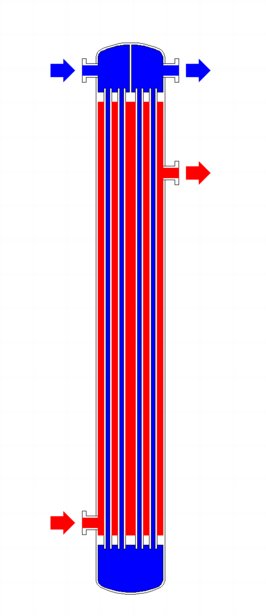Heat exchanger
Heat exchanger is a device used to transfer heat from one medium to another at different temperatures. Heat exchangers are widely used in various industries, including chemical processing, power generation, HVAC (heating, ventilation, and air conditioning), and automotive industries, among others. The primary purpose of a heat exchanger is to conserve energy by transferring heat from a hot fluid to a cold fluid, thereby cooling the hot fluid while warming the cold fluid.
Types of Heat Exchangers[edit | edit source]
There are several types of heat exchangers, each designed for specific applications and operating conditions. The most common types include:
- Shell and Tube Heat Exchanger: Consists of a series of tubes, one set carrying the hot fluid and the other the cold fluid. The tubes are enclosed in a shell, and heat transfer occurs through the tube walls. Shell and tube heat exchangers are widely used in the petrochemical industry and in marine applications.
- Plate Heat Exchanger: Uses metal plates to transfer heat between two fluids. The high surface area of the plates makes them very efficient for heat transfer. Plate heat exchangers are commonly used in the food and beverage industry, HVAC systems, and chemical processing.
- Fin Tube Heat Exchanger: Incorporates fins to increase the surface area for heat transfer. Fin tube heat exchangers are often used in applications where space is limited, such as in automotive radiators and air conditioning systems.
- Regenerative Heat Exchanger: Allows the same fluid to pass through both the hot and cold sides, typically using a rotating wheel or a fixed matrix. Regenerative heat exchangers are used in applications where high efficiency is required, such as in gas turbines and compressors.
Design Considerations[edit | edit source]
The design of a heat exchanger takes into account several factors to ensure efficiency and reliability. These factors include:
- Thermal Performance: The ability of the heat exchanger to transfer the required amount of heat.
- Pressure Drop: The loss of pressure as the fluid moves through the heat exchanger, which should be minimized to reduce energy consumption.
- Material Selection: Based on the fluids being used, their temperatures, and the operating environment to ensure durability and resistance to corrosion.
- Maintenance and Cleaning: Ease of access for cleaning and maintenance is important, especially in industries where fouling can occur.
Applications[edit | edit source]
Heat exchangers play a crucial role in many industrial processes and systems. Some of the key applications include:
- Power Plants: For cooling the working fluid in the turbine cycle, thereby increasing efficiency.
- Chemical Plants: For controlling process temperatures and recovering heat for reuse, reducing energy costs.
- HVAC Systems: In buildings for heating and cooling, using heat exchangers in boilers, chillers, and heat pumps.
- Automotive Industry: In engine cooling systems and exhaust gas recirculation to improve engine efficiency and reduce emissions.
Challenges and Innovations[edit | edit source]
The efficiency and effectiveness of heat exchangers are subject to challenges such as fouling, corrosion, and thermal stress. Research and development in materials science and engineering are leading to innovations such as self-cleaning heat exchangers, advanced coatings to resist corrosion and fouling, and designs that can withstand extreme temperatures and pressures.
Search WikiMD
Ad.Tired of being Overweight? Try W8MD's physician weight loss program.
Semaglutide (Ozempic / Wegovy and Tirzepatide (Mounjaro / Zepbound) available.
Advertise on WikiMD
|
WikiMD's Wellness Encyclopedia |
| Let Food Be Thy Medicine Medicine Thy Food - Hippocrates |
Translate this page: - East Asian
中文,
日本,
한국어,
South Asian
हिन्दी,
தமிழ்,
తెలుగు,
Urdu,
ಕನ್ನಡ,
Southeast Asian
Indonesian,
Vietnamese,
Thai,
မြန်မာဘာသာ,
বাংলা
European
español,
Deutsch,
français,
Greek,
português do Brasil,
polski,
română,
русский,
Nederlands,
norsk,
svenska,
suomi,
Italian
Middle Eastern & African
عربى,
Turkish,
Persian,
Hebrew,
Afrikaans,
isiZulu,
Kiswahili,
Other
Bulgarian,
Hungarian,
Czech,
Swedish,
മലയാളം,
मराठी,
ਪੰਜਾਬੀ,
ગુજરાતી,
Portuguese,
Ukrainian
Medical Disclaimer: WikiMD is not a substitute for professional medical advice. The information on WikiMD is provided as an information resource only, may be incorrect, outdated or misleading, and is not to be used or relied on for any diagnostic or treatment purposes. Please consult your health care provider before making any healthcare decisions or for guidance about a specific medical condition. WikiMD expressly disclaims responsibility, and shall have no liability, for any damages, loss, injury, or liability whatsoever suffered as a result of your reliance on the information contained in this site. By visiting this site you agree to the foregoing terms and conditions, which may from time to time be changed or supplemented by WikiMD. If you do not agree to the foregoing terms and conditions, you should not enter or use this site. See full disclaimer.
Credits:Most images are courtesy of Wikimedia commons, and templates, categories Wikipedia, licensed under CC BY SA or similar.
Contributors: Prab R. Tumpati, MD


